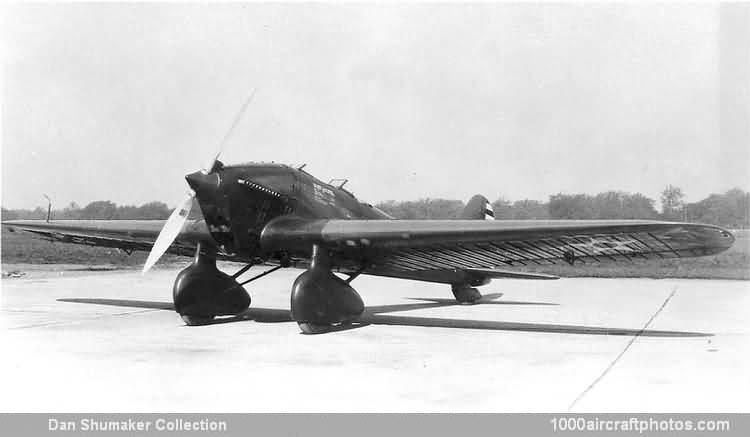Ordered by the USAAC in December 1929 as the XA-7, the Fokker Model 17 was perhaps the most beautiful and certainly the first all-metal American Fokker-design. While the prototype was constructed, the company was renamed General Aviation Corporation in May 1930. The XA-7 was the first USAAC aircraft designed from scratch for the attack role, rather than being converted from an existing type.
The experimental all-metal aircraft had internally braced wings and the streamlined fuselage seated two crew in open tandem cockpits. Initially it had a fixed landing gear with large wheel pants.
Armament consisted of four forward firing 0.30 in (7.62 mm) machine guns, one flexible 0.30 in machine gun for the gunner-observer in the aft cockpit, while also up to four 122 lb (55 kg) bombs could be carried on wing racks. Power plant was a 600 hp Curtiss G1V-1570C Conqueror twelve-cylinder liquid-cooled V-engine.
Fokker regarded the XA-7 as one of the biggest problem cases he had known at the Hasbrouck Heights factory. In the United States it had been Fokker's practice first to built a new plane before offering it to potential buyers. In contrast, the XA-7 military engineers from the outset overlooked the work of the designers and builders. Other problems were related to the all-metal construction, which, despite his earlier experiments, Fokker still had not mastered.
Serialed 30-226, the XA-7 was first flown in January 1931, six months before his great rival, the Curtiss XA-8. It was delivered to Wright Field the following April and tested for several months. In the summer of 1931 the XA-7 was returned to the factory for a major conversion: the nose was completely revised, the landing gear pants were replaced by spats, while also the cockpit windows where changed.
In its revised form the XA-7 was returned to Wright Field, where it started competitive flight test against the Curtiss XA-8. Although Fokker's XA-7 was technically more advanced, the Curtiss XA-8 showed an overall better flight performance. Hence the USAAC opted for the Curtiss product, of which thirteen copies were ordered in September 1931. The development of the XA-7 was halted and it was subsequently scrapped."
Span: 49 ft 9 in (15.16 m)
Length: 31 ft 0 in (9.45 m)
Height: 9 ft 5 in (2.87 m)
Wing area: 333 sq.ft (30.94 sq.m)
Weight empty: 3,866 lb (1,754 kg)
Loaded weight: 5,650 lb (2,563 kg)
Max speed: 184 mph (296 kmh)
Cruise speed: 150 mph (241 kmh)
Landing speed: 61 mph (98 kmh)
Range: 500 mls (805 km)
